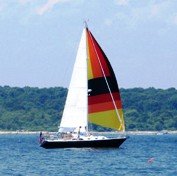Reefing
T,
You should re-think this-as the geometry of the loads on the sail are critical to the integrity of the sail as well as sail shape.
As already noted, by far the best method is to take the reef line directly from the sheave on the end of the boom and go through the clew (reef) cringle, then straight down to the boom-typing a reef knot or bowline around the boom. If the sail is loose-footed, just tie the line around the boom; if you have foot slides, you should be able to tie it between 2 slides at a location directly below the clew (reef)ring/cringle-so that it can slide back when it loads up..If you have a boltrope in the foot on the sail, you will need to cut a slit in the foot of the sail an inch or so above the boltrope directly below the ring-about a 10" slit-so you can pass the reef line through the slit and around the boom..
The main idea here is that as you tension the reef line, it will pull both the leech and foot tight together-self-adjusting and in the right relative amounts-this can only really be achieved by having the end of the reef line free to slide on the boom. When tight, you will have the foot of the sail properly tensioned as the clew comes down to the level of the boom, and in order for the sail not to be improperly loaded this is very important. With the track and car set up (or with a padeye on the boom), you will have to experiment with the location of the car or padeye until you find the spot where you get the right combinations of load when reefed, and if you get a new mainsail with a reef point that is not exactly in the same place as the old one, this location will change.
In the case of reefing setups, the simplest is the best.
S



